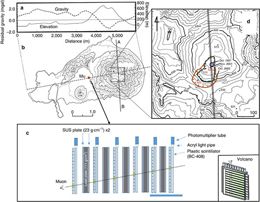Research Abstract
噴火する火山中のマグマダイナミクスの素粒子(ミュオグラフィ)による可視化
Radiographic visualization of magma dynamics in an erupting volcano
2014年3月10日 Nature Communications 5 : 3381 doi: 10.1038/ncomms4381

火山のマグマ流路(火道)中のマグマダイナミクスを素粒子により可視化することで、マグマの上昇と下降、マグマの流れ速度、火道の直径および揮発性物質の膨張と放出によるマグマの膨張と収縮について詳細な理解につながる。本論文では、(宇宙線を起源とする)大気中で生成されたミューオンを用いたイメージング手法(ミュオグラフィ)を動的に適用することで、火道に沿ったマグマの上昇と下降を初めてミュオグラフィ観測した結果を報告する。時系列的なミュオグラフィ画像は、噴煙柱が観測された時にマグマ柱の頂部がクレーター底部直下に上昇したことを示している。加えて、マグマ下降を示す時系列画像も報告する。さらに、火道中のマグマの位置だけでなく、マグマの気体体積の割合の時間変化を監視することで、既存の火山予知手法をサポートできることも提案する。
田中 宏幸1, 草茅 太郎1 & 篠原 宏志2
- 東京大学 地震研究所
- 独立行政法人 産業技術総合研究所
Radiographic imaging of magma dynamics in a volcanic conduit provides detailed information about ascent and descent of magma, the magma flow rate, the conduit diameter and inflation and deflation of magma due to volatile expansion and release. Here we report the first radiographic observation of the ascent and descent of magma along a conduit utilizing atmospheric (cosmic ray) muons (muography) with dynamic radiographic imaging. Time sequential radiographic images show that the top of the magma column ascends right beneath the crater floor through which the eruption column was observed. In addition to the visualization of this magma inflation, we report a sequence of images that show magma descending. We further propose that the monitoring of temporal variations in the gas volume fraction of magma as well as its position in a conduit can be used to support existing eruption prediction procedures.

